FBCB2 US tactical-level automated command and control system (part of 1)
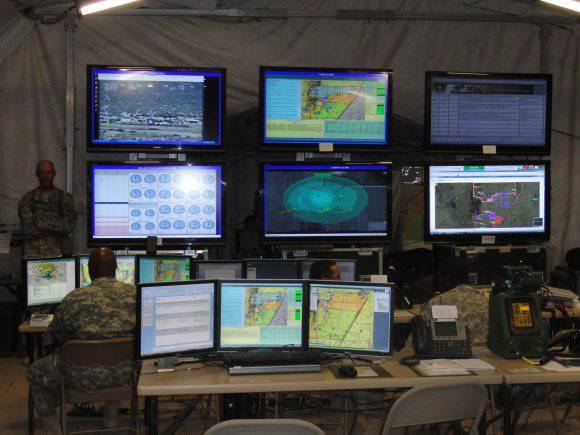
1. Classification
Unfortunately, our military-scientific minds have not yet created a domestic classification of automated troop control systems. Therefore, in the absence of domestic developments, we will use the classification used in the armies of the most developed English-speaking countries.
And in these countries it is customary to divide the automated process control system into several classes depending on the functions performed by the systems - Command, Control, Communications, Computers, Intelligence, Surveillance, Reconnaissance (Command, Control, Communications, Computers, Intellect, Surveillance and Intelligence).
In this case, we are mainly interested in the division of systems according to the degree of automation of management processes in accordance with this classification.
It should be noted that the listed military terms used in “their” classification carry meanings that are far from identical to the meanings that, in accordance with our military terminology, we put into these words. But more about that later.
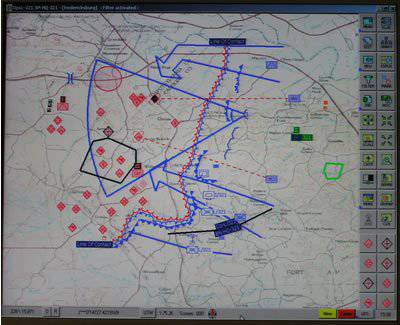
In the meantime, we simply state the fact that any automated control system belongs to a certain class in accordance with the degree of automation in it of the management functions that are indicated above. If any of the listed functions is automated in the system in full, then the abbreviation of the class of this system will contain the initial letter of this function.
Thus, control systems in which only two functions are automated, for example, Command and Control, will be classified as “CC”. For simplicity, the class abbreviation is denoted as "С2"
If the system has four automated functions (Command, Control, Communications, Computers), then such a system should be classified as “SSSS”, or “С4”.
At the same time, in the opinion of the “dear comrades of the imperialists,” the functions beginning with the sacramental letter “C” are basic, and all the rest are additional.
In short.
From the point of view of automation of management functions (tasks), the management system that belongs to a class containing more letters “C” in its abbreviation will be more “advanced”.
For example, the system of the С2SR class will be inferior to the “simple” system of the С4 class in terms of the “latitude of the spectrum” of tasks solved in an automated mode.
2. Tasks
As for the “content” of management functions.
Systems in which the Command and Control functions are automated should perform the following tasks in an automated mode:
1. Display and transfer of formulated combat tasks to subordinate controls (control objects) in a formalized text and graphic form (files) using a single "seamless" computer network.
2. Automatic determination of the position of their control objects (up to a separate vehicle) and periodic notification of their controls and neighbors about their location with display on electronic maps.
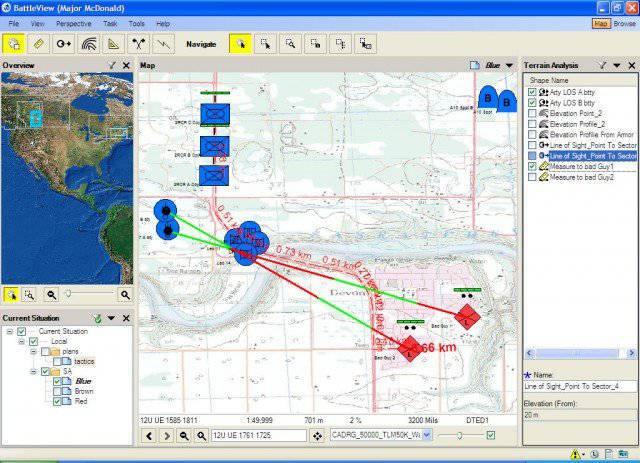
3. Manual or semi-automatic (using a range finder) displaying on electronic maps and automatic exchange of data on enemy objects, obstacles and infrastructure elements on the battlefield, detected (by objects) by system elements.
4. Automatic calculation and selection of routes based on known data on the road network and display of the path traversed by the system object (BFT - blue force tracking).
In simple terms, the C2 systems allow the commander to only quickly bring the decision he made to his subordinates and monitor the progress of its implementation.
At the same time, the functions of assessing the situation and making decisions are completely assigned to the “natural computer” of the commander himself — that is, his brain.
And, of course, the favorite term of Western specialists is “situational awareness”! That is, the system reports to any control object (besides the commander himself) about the status and condition of the neighbors during the performance of combat missions.
In addition, part of the systems belonging to the C2 class are able to perform mutual identification of objects within the system according to the principle of “friend or foe”, as well as carry out target identification and automatic target targeting to fire destruction equipment included in the system.
Control systems in which such functions are automated are designated as “SR” (Surveillance and Reconnaissance), and are designated as С2SR, or С2 +.
At the same time, computers used in the “С2” class systems are considered by Western specialists only as a means of PRIMARY (and not complete!) Processing and display of information. Therefore, even though С2 systems have personal computers in their composition, they do not have the word “Computers” and the corresponding letter in the abbreviation of their class.
In other words, the СHNUMX class system only helps the commander and other servicemen to assign tasks to the subordinates, COLLECT AND DISPLAY information about the current position of their control objects, the position of the enemy and neutral objects.
In fact - that's all.
At the same time, there is no talk about "intellectual support for decision-making" and even more so - about the development of any solutions for a fight and their modeling.
But such a task as the automatic organization of communication networks and local computer networks is already a distinguishing feature of systems that have the abbreviation of the word Communications in their class (third C).
The presence in the abbreviation of the class of the fourth letter "C" (Computers), as well as the letter "I" (Intelligence) implies, firstly, - FULL automatic processing of data obtained during the implementation of the first two "C" - Command and Control . And secondly, the development on the basis of the processing of the primary data of the OPTION OF THE SITUATIONAL DECISION of the commander and his presentation in the most convenient form for human perception.
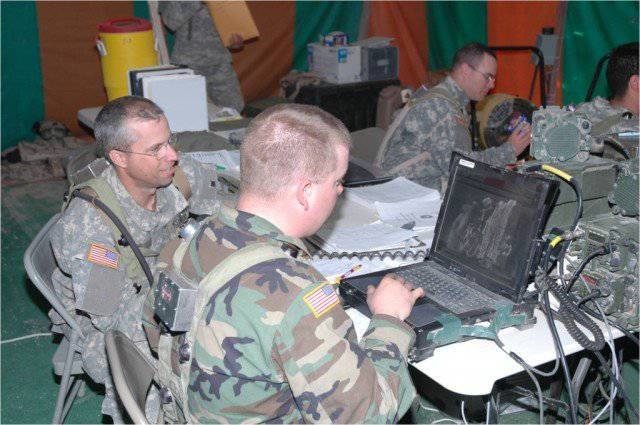
An important note for the Russian generals: the simple presence of color screens at the control point with the flags and icons of different colors displayed on them against the electronic topographic map is NOT a sign of a high level of automation of the command and control system!
Moving on.
Systems of class "С4" (in addition to performing functions implemented in systems of class "С2" and "С3") should be able to solve the following tasks:
1. Full automation of methods for collecting and processing information.
2. Information support by the commander of the development of solutions (availability of programs like "Sketch in the decision" (Sketch in the decision).
3. Mathematical modeling of the results of hostilities for selected options for performing combat missions (Blitzkrieg (Blitzkrieg) high-speed analytical program) with a graphic display of the simulated progress and the results of hostilities on electronic maps, including using the three-dimensional display of the battlefield.
4. Information support for the development of planning documents (the program “Sketch in the plan” (Sketch into the plan), which transforms graphic and audio materials into planning documents.
5. Information support for making private decisions in the course of a combat mission (the program “Crystal sphere” (Crystal Ball), which updates the estimates and conclusions based on information obtained during the operation)
We summarize: the fundamental difference between the C4I class systems and the C2 class is the higher degree of automation of information (management) tasks.
And now, ATTENTION!
In the armies of even the most industrially advanced countries, all systems of the C4I and C4SR class, in their membership of the military command level, belong only to operational control or operational-strategic level control systems.
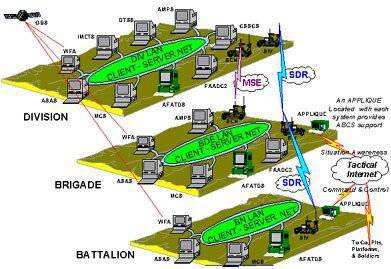
At the present time, all the automated command and control systems of the tactical level in the armament of foreign countries belong to the C2 or C2 + class, and differ only by a small expansion of the range of tasks. At the same time, all tactical systems fundamentally “do not reach out” even to the “С3” class.
According to experts, the main obstacles to the development of the ACCS tactical link from the СХNUMX class to СХNUMX and С2 classes are:
- the absence of mathematically correct algorithms for evaluating the actions of troops at the tactical level, due to the huge variety of methods and techniques used by them to perform combat missions;
- the difficulty of creating an automated system for collecting and evaluating data of a tactical situation, due to the very large variety of its parameters and the transience of changes (compared with the operational management level)
- arising, in connection with the preceding paragraph, the need for manual work to collect, process and display a large number of variable data, exceeding the capacity of responsible officials to enter such data into the system;
- the need to process a relatively large amount of data per unit of time, which in terms of their volume currently exceeds the capabilities of the machine software used in the tactical control unit;
- the complexity of creating self-organizing communication networks and reliable local area networks (data transmission systems) between a large number of highly mobile control objects.
3. Ambitions
A little bit stories.
At the beginning of the 1990s in the United States, the idea to use computers to control military units and subunits came to someone's clever mind.
For some time the idea was in the air. And then, the Americans, with their usual business pragmatism, began to put it into practice.
I believe that without DARPA (Defense Advanced Research Projects Agency) it was not done here, but it does not matter.
And the important thing is that in the middle of 90's, the states announced a very ambitious program “Future Combat Systems” (Future Combat Systems). As part of its implementation, it was intended to develop a central network concept of a multi-purpose combat system that will have a great destructive effect, ready for deployment in the shortest possible time, autonomous and very tenacious in battle through the use of a set of automated control of single crew and crewless ground and air platforms. The aim of the FCS program was to develop such a complex weapons, means of processing and transmitting data, which will allow to achieve the optimal balance between the indicators of decisive tactical and technical characteristics and the maximum completeness of their use in battle.
According to the developers of the program, a unit equipped with the FCS system must be able to adapt to the changing volume of tasks during deployment and combat operations ranging from conventional combat (operation) to peacekeeping operations. Equipped with a system of FCS troops were to receive:
1. Unified transport and armored platforms.
2. Autonomous robotic systems.
3. The functionality of the command and mobile control objects equipped with computers, united in a control network, communications corresponding to the С4 class;
4. The possibility of observation, reconnaissance, detection and guidance in an automated mode for all elements (control objects) of the system.
5. The possibility of high-precision direct and indirect fire for all means of destruction, combined with the means of reconnaissance and control into a single network.
They set to work zealously. However, further development of the very concept of creating such a system, creating in single copies of elements of hardware and software systems, as well as individual samples of high-tech radio stations and prototypes of robotic tools, did not go.
Although not. There were also a number of well-directed videos (and now online) that told and showed how effective such a system would be if it could be created.
By the way, on the Russian-language Internet, individual users like to give references to these “cartoons” as a support for their arguments like “But how they are - cool!”
Nevertheless, all the developments within this program, as well as their intermediate results, were presented to the American public with great fanfare. It is understandable - the money spent was by no means small.
But. It was not possible to achieve real success (demonstrated at test sites and not in presentation clips) in creating an automated control system for the TACTICAL LEVEL of the С4 class. All its elements were worked out rather weakly. It is possible that this is due to the excessive complexity and scale of the tasks set, as well as to a significant reduction in the US military budget.
In short.
In May, 2011, the press appeared official reports on the closure of the program FCS.
This time, without any pump.
However, this does not mean that the United States has completely abandoned the improvement of its technologies in the field of automation of the management of military formations. Part of the developments, in particular, on unmanned aerial vehicles and means of transmitting information was transferred to other programs.
4. Simple moves
Currently, the most well-known of all existing ACCS tactical level is the American system class "С2SR" - "Force XXI Battle Command Brigade and Below" (FBCB2). This title in a very loose translation can be voiced as "The control system of the brigade and subordinate units in the battle (battle) of the twenty-first century."
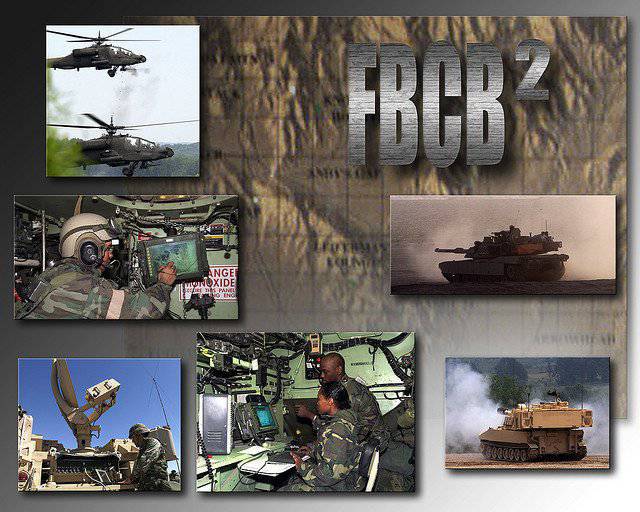
At about the same time that optimism about the Fighting System of the Future program was still very high, Northrop Grumman Corporation, without much ado, received an order to develop an automated control system for the brigade-battalion-company-platoon-control link department (tank) ". Well, and appropriate financial support for the implementation of this project. Naturally, after appropriate military-scientific studies of the issue submitted, by the way, to the relevant committee of the US Congress for consideration!
The essence of the project was as follows.
It was supposed to create a reliably functioning system of the C2 class, which would unite not “promising combat platforms” (which were still at the stage of conceptual designs by 1995), but the means of warfare already existing in the troops. That is, the “good old” tanks M1 Abrams, BMP M2 and BRM M3 Bradley, as well as the M-113 BTR. Well, still multi-purpose cars HMMWV.
And ..... at times to increase their combat effectiveness simply by reducing the battle control cycle and increasing situational awareness.
In the FBCB2 ACCS development, only in one 1996 fiscal year, about 47,6 million dollars were spent. And from 1997 to 2004, the year was spent on refining the system and eliminating the identified deficiencies, according to various estimates, from 270 to 385 million dollars.
According to some data, the total amount of contracts related only to the development and improvement of the system from 1995 to 2010 is estimated at 800 million dollars.
A lot. But the result was impressive.
Having overcome a huge number of problems and cured an incalculable number of "childhood diseases", NG specialists achieved the system's compliance with the requirements of the military.
The serial production of the FBCB2 ACS has been established since 2002.
In 2003, the system received "baptism of fire" in Iraq as part of the 4 mechanized division, which received the nickname "Digitized" ("digital") after equipping with FBCB2 kits. All tanks and infantry fighting vehicles of the division were equipped with the appropriate system complexes before being sent to the combat zone. This version of the modernization of tanks and infantry fighting vehicles received the name "SEP" (program to expand the capabilities of the system).
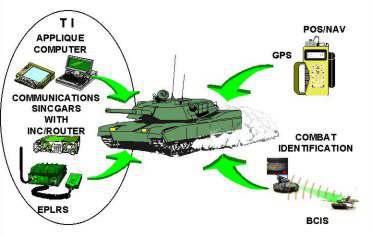
Based on the results of the hostilities in Iraq, as well as the tests that continued on the continental US, a series of upgrades to the hardware and software components of FBCB2 were carried out.
So, since October 2008, the implementation of the upgraded version of the fifth software version (V1.5) has been started.
According to the plan, by the end of 2011, each FBCB2 system’s hardware and software complexes (APC) had to be equipped with every tank, infantry fighting vehicle, self-propelled artillery system and all the commander vehicles of the US Army Brigades and Marine Corps (more than 100 000 sets). Before 2015, it is planned to equip each soldier with specialized combat units with portable systems.
Currently (data for December 2011 of the year) about 85 000 (eighty-five thousand) sets of workstations for equipping control points and individual combat vehicles (vehicles) have already been delivered to the US Army and Marine Corps.
5. Iron
What is the FBCB2 hardware?
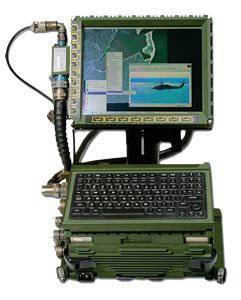
The system complexes are available in two versions. The main one is the AN / UYK-128 Applique computer-based software with touch screens (500MHz / 4Gbyte / Windows 95 / NT in a highly rugged box) connected to the NAVSTAR system receiver and a digital radio station and using combat control software.
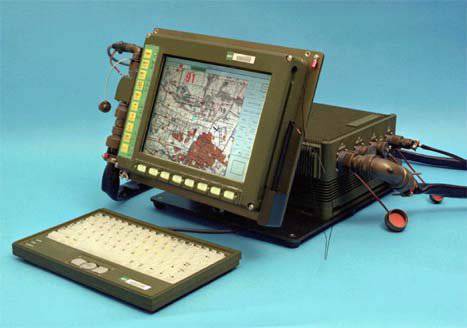
The second option is a purely software version for information processing devices built into weapons systems. The FBCB2 equipment is docked with other on-board devices and combat vehicle systems, (including a laser rangefinder), for mutual identification, automatic generation of messages about enemy targets and call for fire.
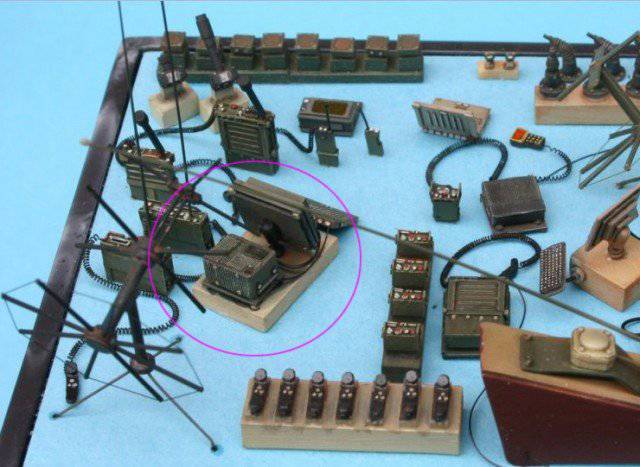
The APC fits in with various means of data transmission (communication devices of various ranges). Data exchange in the "tactical Internet" (TI) is performed using radio communication systems EPLRS and SINGARS, and L-band Inmarsat mobile satellite communication system
The appearance of the kit in the first version is shown in the figures. The circle in the picture with communication means the system unit, keyboard, and multifunction display of the computer AN / UYK-128 Applique.
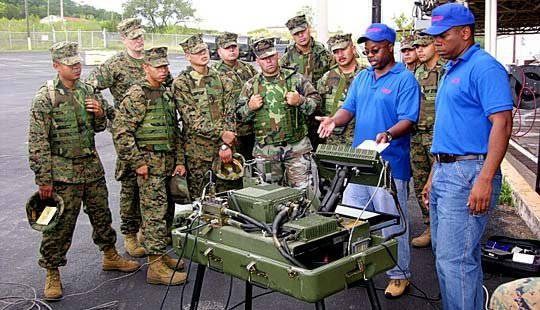
Such kits are the same for all levels of “brigade-branch (tank)” level of management and can be mounted (deployed) at the brigade’s field control points (building, tent, recessed, or protected control point), on any vehicle such as armored vehicle (tank, BMP, BRM, BTR), as well as by helicopter.
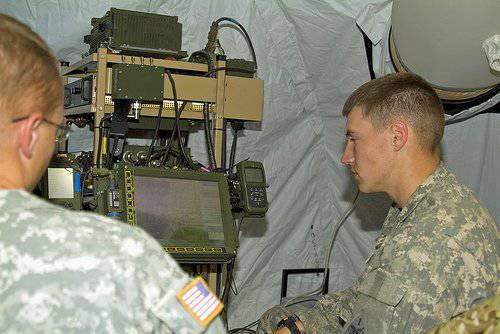
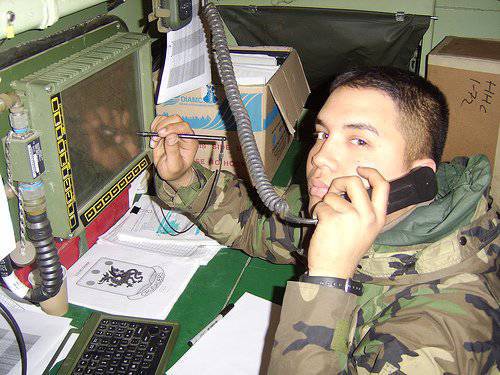
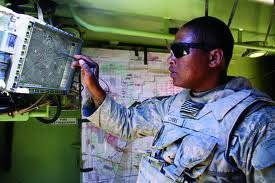
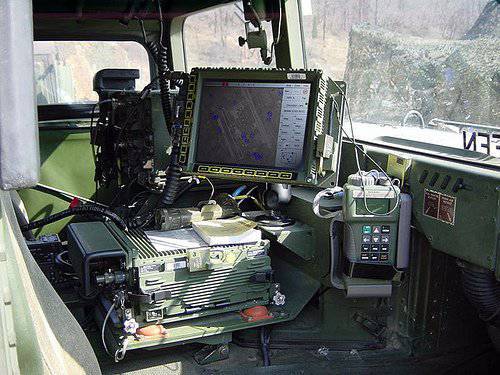
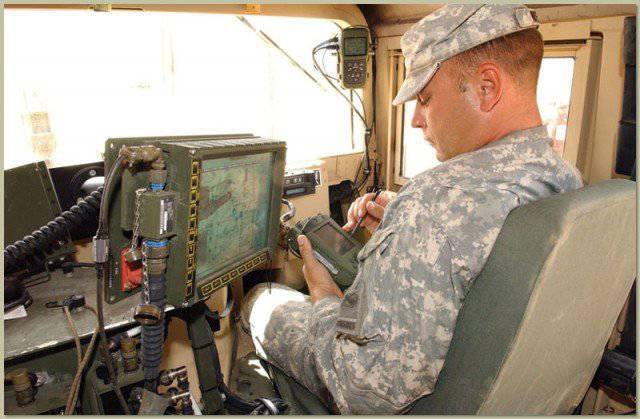
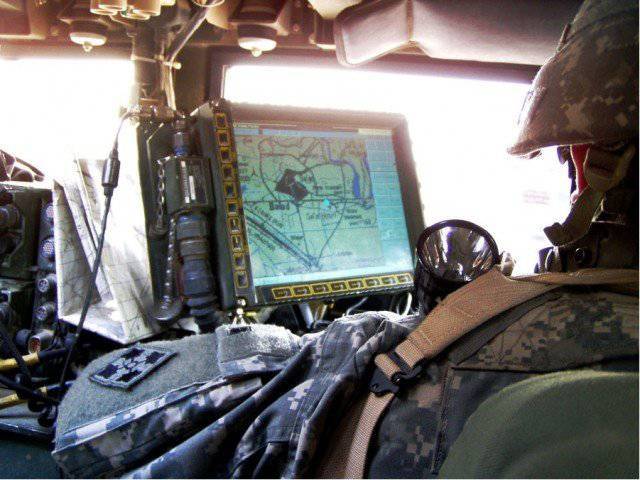
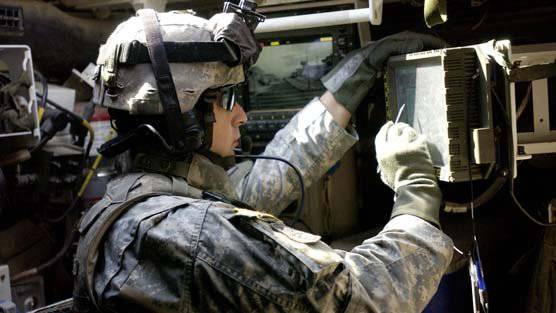
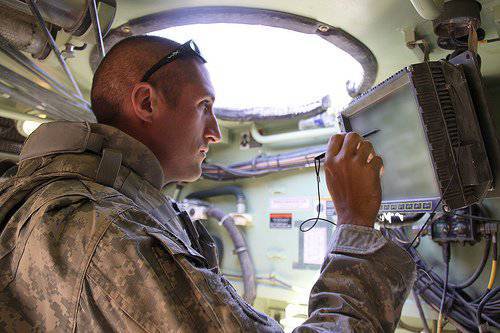
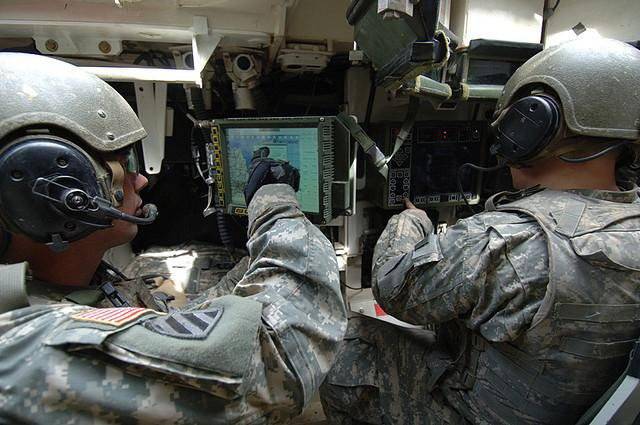
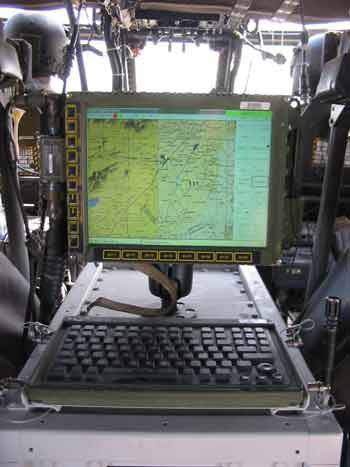
7. Devices
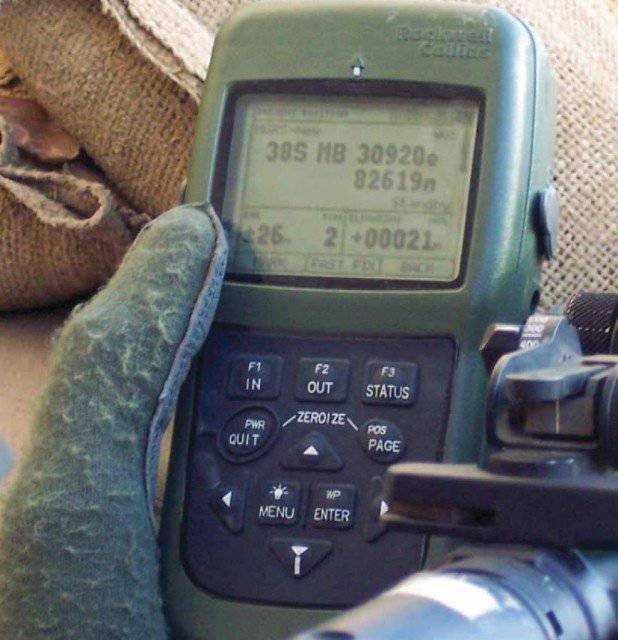
In addition to the actual system unit, interactive display and keyboard, which are rigidly mounted on the vehicle, several other wearable devices are also included in the FBCB2 hardware and software complex. Such devices were named "FBCB2-Light Handheld". The picture on the left shows a GPS navigator that allows an individual soldier outside the vehicle to track his position using the global positioning system NAVSTAR.
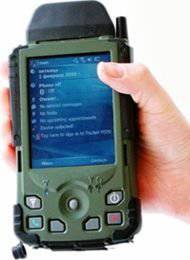
For mounting remote devices directly to the machine, there are special sockets and corresponding connectors for connecting it to the other blocks, as well as for recharging the batteries.
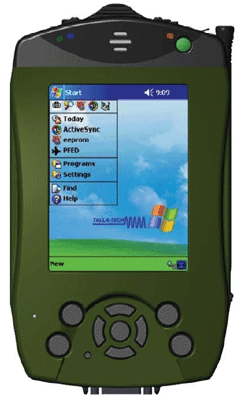
In addition to the navigator, each set includes a communicator that allows a soldier outside the vehicle to receive (send) short text messages, receive and display tactical information transmitted by other sets, determine their position with reference to an electronic map, and also calculate and display on the electronic map the shortest paths of movement between points, taking into account the presence of the road network.
The original versions of the communicator had the form shown in the pictures on the left.
According to the US military, the main drawbacks of the intermediate versions of communicators were their dependence on the GPS receiver (they must work “in pairs”), the small capacity of the batteries, and the inability for the user to make changes in the tactical situation.
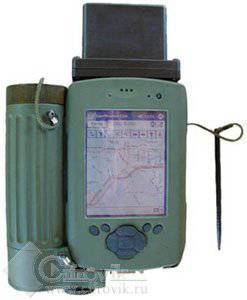
Therefore, in the course of further improvement of the system, a wearable device was finally developed, devoid of such shortcomings.
As a result of the modernization of the complex, the communicator acquired the form shown in the figure below. The finned tube to the left is the case - this is an additional battery device. Top cylinder - GPS receiver antenna. The operating time of this version of the communicator with an additional battery is about 12 hours.
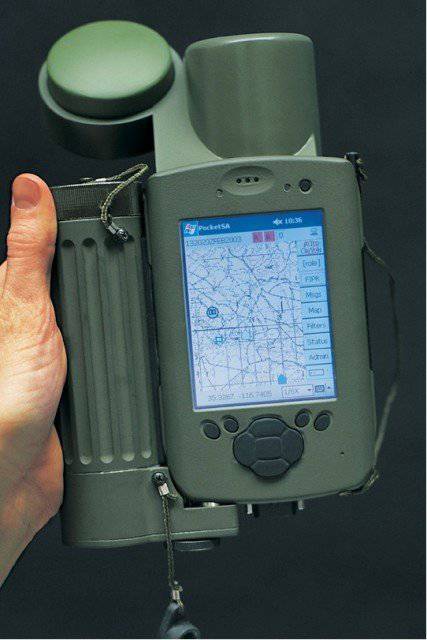
In the modernized device, the communicator was combined with the GPS-navigator, and also introduced into the software the possibility for the user not only to receive information about the situation, but also to form its elements and transfer them to other users.
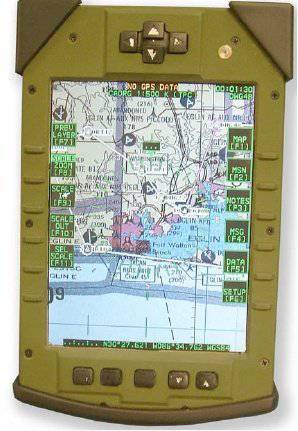
The next version of the communicator is called “Electronic Data Manager” (EDM), or “Knee-Board”, and also combines the functions of a handheld computer and a GPS receiver.
A significant drawback of this option is the limited time it runs on batteries. Therefore, it is intended for use only by army pilots aviation
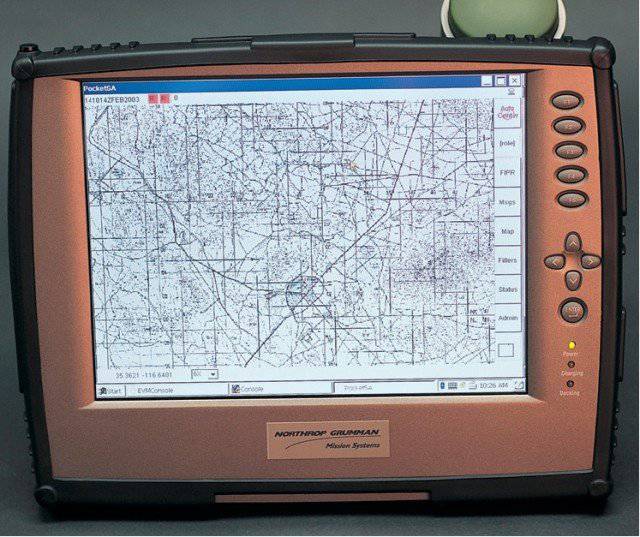
Possible variant of the portable system module (tactical terminal) for the commanders of "simple infantry".
Despite the fact that the portable version of the terminal is essentially a tablet computer with the implementation (duplication) in it of all the functions of the main (portable) set, it has not yet become widespread and is a prototype.
The main snag here is that communication with communicators is carried out in the microwave range using the base station located in the vehicle (armored vehicle). That is, the communication range is limited by the power of the base station, as well as by the peculiarity of radio wave propagation frequency 1,2-2,4 MHz. And such waves, in contrast to the radio waves of the VHF range, can propagate only in the line of sight. Any obstacle in their path (buildings, trees, bushes, not to mention the folds of the terrain) leads to loss of communication.
The figures below show a set of communication facilities and data transmission devices that are necessary to ensure the full operation of the portable version of the AIC with full duplication of all functions of the mobile version of the complex. At the same time, wearable VHF radio is used for data transmission.
A soldier using a tablet version of a computer will be “loaded” like this:
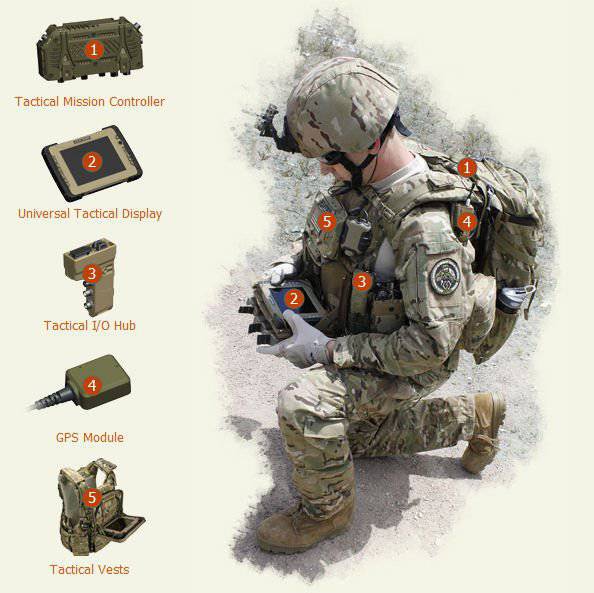
And if you think that a fighter in a backpack on his back carries ammunition and other things necessary in battle, then you are mistaken. Almost all the place in it is occupied by all sorts of glands.
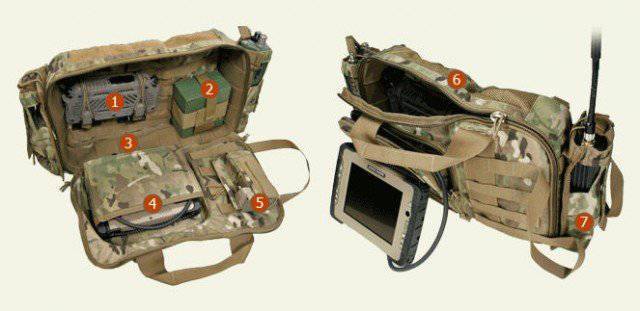
In other words, a backpack is just a package for storing and transporting devices for processing, displaying and transmitting information, as well as batteries.
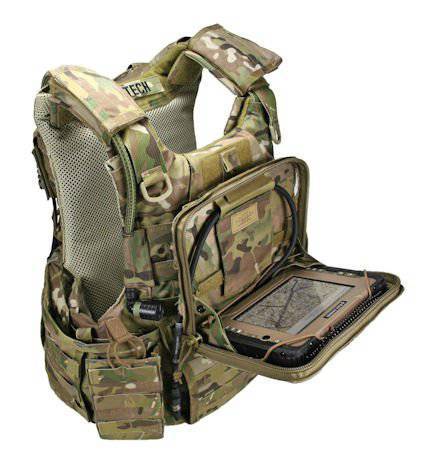
A special vest has also been designed to accommodate elements of all equipment that ensures the operation of the complex.
And the general layout of the placement of wearable equipment of the complex on a serviceman looks like that shown in the pictures below:
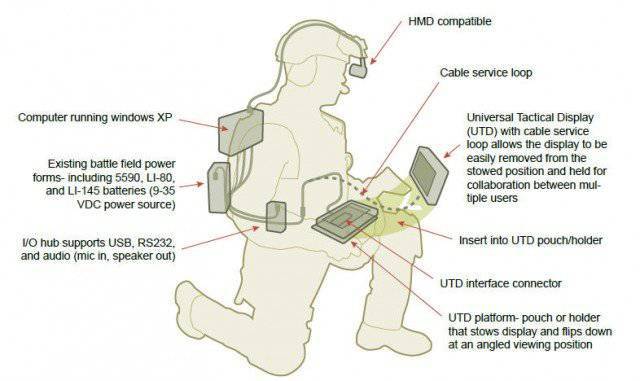
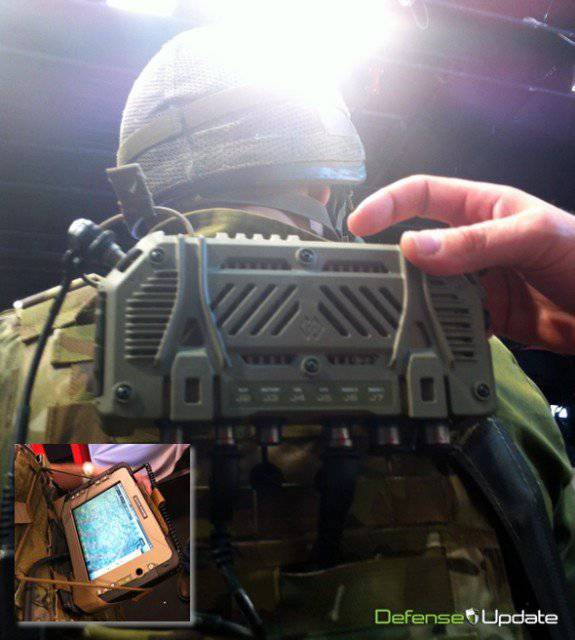

Information